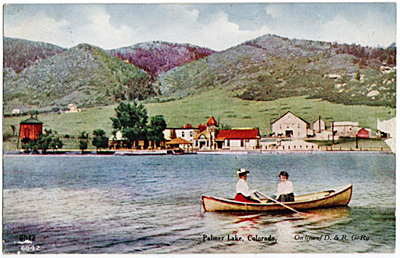
.
In June of 1971 the Palmer Lake Town Council received a cease and desist letter from the Colorado Department of Health and Environment (CDH) stating that the Town cease allowing any more septic systems to be installed and that a completely new sanitary collection and disposal system must be installed. The ever increasing population was overloading the individual septic systems in the area and the Town must take action to eliminate the problem.
The Town Council held meetings to inform the public of the emergency imposed by the CDH. The CDH and the Environmental Protection Agency (EPA) were in attendance to help explain the need for the collection and disposal system and to help explain the guidelines for forming a Sanitation District.
The Palmer Lake Town Council formed a steering committee of interested Town citizens to continue the process of forming a Sanitation District under the State Statute Title 32 for Special Districts. With the help of these dedicated individuals, the Palmer Lake Sanitation District was established on October 29, 1971.
The Colorado Department of Health strongly recommended that the Palmer Lake Sanitation District join with the Monument Sanitation District and the Woodmoor Water and Sanitation District #1 to build and operate a common wastewater treatment facility. This treatment facility would be built on the , then, present site of the Monument lagoon system on the southwest corner of Arnold Ave and Mitchell Ave.
After the steering committee met in July, 1972 with the Monument and Woodmoor Sanitation Boards, it was decided to enlarge the Monument Lagoon system and form an agreement calling the new entity the Palmer Lake, Monument, Woodmoor Treatment Facility. The EPA and CDH would assist with the funding for Palmer Lake Sanitation District’s complete collection system and outfall lines with a pledged grant of $394,275.00. With this commitment for funding in place several Town Hall meetings were held, again with the help of the EPA and CDH, to place before the voters of the Town a bond issue to complete the necessary funding for the engineering costs and construction of the collection system, outfall lines and treatment facility. The vote passed and the Palmer Lake Sanitation District was on it’s way to having a completely new wastewater collection system.
All was looking good until a lawsuit was filed by several residents of the Pine Hills Subdivision threatening to stop the project. This lawsuit did delay some of the work, basically on the expansion of the lagoon, but the engineering for the collection system was completed by NHP&Q Engineering of Greeley, Colorado on March 2, 1973. Also, the lawsuit did not stop the steering committee from holding the District’s first formal election on August 14, 1973 and electing five members as it’s first Board of Directors.
With a formal Board of Directors in place, EPA and bond funding in place, a contract was let in September, 1973 for Shawnee Construction Company from Kansas City, MO to begin installation of the sewer collection lines. Plastic PVC pipe was a fairly new product at the time and the Board had the foresight to use PVC piping for all of the collection and outfall lines.
On July 15, 1975, Federal Judge Sherman Finesilver ruled against Pine Hills Subdivision, so the renovation of the Monument lagoon to an activated sludge lagoon started. The contract for this renovation was funded by 75 percent from the EPA, 5 percent from the State of Colorado, leaving the remaining 20 percent for the Districts to fund. Final cost for this renovation was approximately $300,000.00.
The completion of the collection and outfall lines occurred in August, 1974 and the first use of the lines into the Monument lagoon was on October 21, 1974. For the next several years the Palmer Lake Sanitation District made an all out effort to tap as many homes onto the new collection system as possible. As all three communities were growing it was clear that further expansion was needed so construction began and on November 25, 1976 with the new activated sludge lagoon completed the three Districts officially named the facility, The Tri Lakes Wastewater Treatment Facility.
In October, 1977 with a first class treatment plant, a new facility name, Palmer Lake Sanitation District, Monument Sanitation District and Woodmoor Water and Sanitation District #1 signed an agreement for the daily operation of the facility.
With the growth in the three communities there was a need to revise the working agreement signed in 1977. On June 6, 1996 the three participating Districts signed the “Amended Joint Use of Facilities Agreement” (AJUA), replacing all prior agreements. This new Amended Joint Use of Facilities Agreement detailed the management of the facility by the participating Districts which comprised of one member of the Board of Directors of each District to serve on the Board of the Joint Use Committee. The Tri Lakes Wastewater Treatment Facility is owned by the Districts in equal, one-third interest. The operating expenses are billed to the individual Districts monthly by each District’s pro rata flow and Biochemical Oxygen Demand (BOD) loading. Forty percent of the expense attributed to influent flow and sixty percent of the expense attributed to BOD loadings.
The Palmer Lake Sanitation District paid off the original bond issue, therefore eliminating any further mill levy taxes on real estate. The District moved into a new office building January 2, 2004 and in the past 40 years has grown to provide service to approximately 967 residential and 56 commercial customers. As there are no property taxes levied, the District’s daily operations and our share of the treatment plant operations are funded entirely by tap and service fees.

